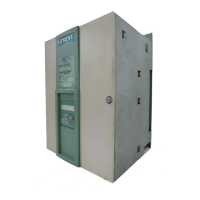Connections 05.05
6-16 Siemens AG 6RX1700-0AD76
SIMOREG DC Master Operating Instructions
where
()
Ω×−×=−=
DN
d
v
DKN
Lf
I
U
XXX
π
203536.0
0
and
U
v0
No-load voltage in V at the converter supply connection point
I
d
DC current in A of operating point under investigation
f
N
Line frequency in Hz
L
D
Inductance in H of commutating reactor used
X
D
Impedance of the commutating reactor
X
N
Impedance of the network
X
K
Impedance at the converter terminals
II.) Armature inductance L
a
()
H0488.0
N
0v
a
d
I×
×=
f
U
L
A separate calculation must be performed if the actual values for short-circuit power S
K
and/or
armature inductance L
a
deviate from the values calculated on the basis of the above equations.
Example
Let us assume that a drive has the following data:
U
v0
= 400 V
I
d
= 150 A
f
N
= 50 Hz
L
D
= 0.169 mH (4EU2421-7AA10 where I
Ln
= 125 A)
When
Ω=×××−×=
−
0412.010169.0502
150
400
03536.0
3
N
π
X
the required system short-circuit power at the converter supply connection point is as follows:
MVA88.3
0412.0
400
2
K
==S
and the required motor armature inductance as follows:
mH60.2
15050
400
0488.0
a
=
×
×=L
The harmonic currents I
ν
listed in the tables above (where I
1
= g x 0.817 x I
d
for firing angles α =
20° and α = 60°) apply only to the values S
K
and L
a
calculated by the above method. If the
calculated and actual values are not the same, the harmonics must be calculated separately.
For the purpose of dimensioning filters and compensation circuits with reactors, the harmonic
values calculated by these equations can be applied only if the values calculated for S
K
and L
a
tally
with the actual values of the drive. If they do not, they must be calculated separately (this is
especially true when using compensated motors as these have a very low armature inductance).

